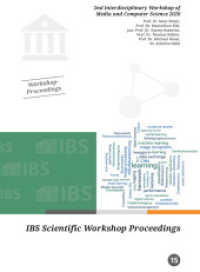- ホーム
- > 洋書
- > 英文書
- > Business / Economics
基本説明
Evaluates the competitiveness of the Taiwanese tourism sector by a multi-dimensional framework.
Full Description
International tourism is expected to be a major vehicle of economic development in industrializing countries in the 21st century, especially for Asia. To generate long-term growth, countries with tourism-based economies must develop strategies for employing their comparative advantages to achieve competitive advantages. However, competitiveness in the tourist industry is multi-dimensional and complex. This study evaluates the competitiveness of the Taiwanese tourism sector by a multi-dimensional framework. The theoretical model proposes that the competitiveness of tourist destinations should be composed of Ricardian comparative advantages (like the conditions of natural endowments and the degree of technological change); Porterian competitive advantages; tourism management, i.e., providing high quality education and job training, public goods, support services and reduced transaction costs to enhance comparative and competitive advantages; and environmental conditions.
Contents
Literature Reviews.- Research Methods.- Weight of Indicators and Decision Analyses.- Conclusions and Future Works.








